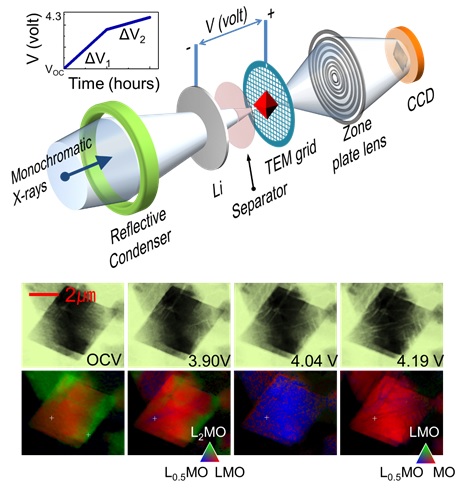The energy density of current batteries is limited by the practical capacity of the positive electrode, which is the determined by the properties of the active material and its concentration in the composite electrode architecture. The observation in dynamic conditions of electrochemical transformations creates the opportunity of identifying design rules toward reaching the theoretical limits of battery electrodes. But these observations must occur during operation and at multiple scales. They are particularly critical at the single particle level, where incomplete reactions and failure are prone to occur.
Micrometric-sized lithium-manganese spinel cathode material - Li1+xMn2-xO4 - is one of the state-of-the-art materials for Li-ion batteries. During the electrochemical reaction, up to 2 mol Li can be intercalated into Mn2O4, but only half can be reversibly cycled for electrochemical application. Strategies that enable durable cycling between Li2Mn2O4 and Mn2O4 would result in capacities well above 200 mAh·g-1, the current limit in positive electrode materials. Achieving this goal with crystal sizes at the microscale would minimize deleterious interfacial reactions, as well as potentially increase the storage density of an electrode by avoiding poorly packed, porous nanopowders. Finally, understanding how a phase transformation proceeds in a crystal can provide guidance to engineers striving to reduce the amount of inactive materials such as conductive additives and binders so as to increase the energy density of a system.
In this study, operando full field transmission x-ray microscopy (FF TXM, as shown in the schematic drawing in Figure 1) was coupled with x-ray spectroscopy to follow the chemical and microstructural evolution at the nanoscale of single crystals of Li1+xMn2-xO4. In the lower part of the figure, it is demonstrated that the onset and crystallographic directionality of a series of complex phase transitions were successfully followed and correlated with particle fracture. The dynamic character of this study reveals the existence of non-equilibrium pathways where phases at substantially different potentials can coexist at short length scales. The results could be used to inform the engineering of particle morphologies and electrode architectures that bypass reversibility and durability issues observed here and lead to optimized battery electrode properties.

Figure 1. (Upper panel) Schematic illustration of operando FF TXM-XANES. Electrochemistry was carried out using linear voltammetry at two consecutive sweep rates, ΔV1 and ΔV2. Images were acquired at different X-ray photon energies and cell potentials, and chemical maps were produced by fitting the corresponding XANES spectra of each pixel. (Lower panels) Representative chemical and morphological maps of selected single octahedral spinel microcrystals during the electrochemical reactions. The red, green, and blue colors represent the chemical components of MO (Mn2O4), L0.5MO (Li0.5Mn2O4), LMO (LiMn2O4), and L2MO (Li2Mn2O4) as indicated by the color triangles.
Y.-S. Yu, C. Kim, Y. Liu, A. van der Ven, Y. Shirley. Meng, R. Kostecki and J. Cabana, "Nonequilibrium Pathways during Electrochemical Phase Transformations in Single Crystals Revealed by Dynamic Chemical Imaging at Nanoscale Resolution", Adv. Eng. Mater. (2014), DOI: 0.1002/aenm.201402040.




